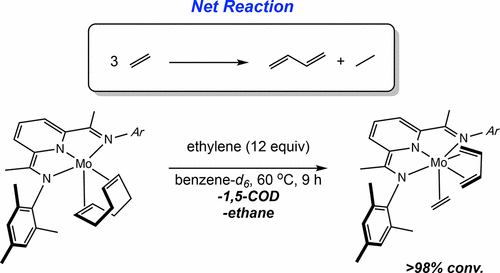当前位置:
X-MOL 学术
›
Organometallics
›
论文详情
Our official English website, www.x-mol.net, welcomes your feedback! (Note: you will need to create a separate account there.)
Synthesis and Reactivity of Pyridine(diimine) Molybdenum Olefin Complexes: Ethylene Dimerization and Alkene Dehydrogenation
Organometallics ( IF 2.8 ) Pub Date : 2017-10-30 00:00:00 , DOI: 10.1021/acs.organomet.7b00653 Matthew V. Joannou 1 , Máté J. Bezdek 1 , Khalid Al-Bahily 2 , Ilia Korobkov 2 , Paul J. Chirik 1
Organometallics ( IF 2.8 ) Pub Date : 2017-10-30 00:00:00 , DOI: 10.1021/acs.organomet.7b00653 Matthew V. Joannou 1 , Máté J. Bezdek 1 , Khalid Al-Bahily 2 , Ilia Korobkov 2 , Paul J. Chirik 1
Affiliation

|
Reduced pyridine(diimine) molybdenum olefin complexes have been synthesized and structurally characterized. Examples with 1,5-cyclooctadiene, (PDI)Mo(η2:η2-1,5-COD) (COD = 1,5-cyclooctadiene) adopt a distorted-trigonal-bipyramidal geometry and are best described as low-spin Mo(II) compounds arising from significant π back-donation to the ligand from a reduced molybdenum center. With the 2,6-diisopropyl N-aryl-substituted variant of the pyridine(diimine) ligand, a molybdenum bis(ethylene) complex was obtained. Reducing the size of the N-aryl substituents to 2,4,6-trimethyl resulted in isolation of (MesPDI)Mo(η4-butadiene)(η2-ethylene) following sodium amalgam reduction of the corresponding molybdenum(III) trichloride complex in the presence of excess ethylene. Analysis of the byproducts of the reaction and olefin addition experiments demonstrate that butadiene formation is consistent with a pathway involving ethylene coupling to form 1-butene followed by allylic dehydrogenation to produce butadiene. Excess ethylene serves as the hydrogen acceptor. The dehydrogenation reaction was also compatible with α-olefins, as reduction of either (iPrPDI)MoCl3 or (MesPDI)MoCl3 in the presence of 1-hexene resulted in isolation of (PDI)Mo(η4-1,3-hexadiene)(η2-1-hexene) complexes. An α,ω-diene complex, (iPrPDI)Mo(η2:η2-1,6-heptadiene), was also synthesized and importantly displayed no cycloaddition chemistry, suggesting that first-row metal pyridine(diimine) complexes are thus far unique in promoting cyclobutane synthesis.
中文翻译:

吡啶(二亚胺)钼烯烃复合物的合成和反应性:乙烯二聚和烯烃脱氢
还原的吡啶(二亚胺)钼烯烃复合物已经合成并进行了结构表征。与1,5-环辛二烯的例子,(PDI)的Mo(η 2:η 2 -1,5-COD)(COD = 1,5-环辛二烯)采用扭曲-三角-双锥并且最好被描述为低旋Mo(II)化合物是由还原的钼中心向配体的显着π返配产生的。用吡啶(二亚胺)配体的2,6-二异丙基N-芳基取代的变体,获得钼双(乙烯)配合物。降低了N-芳基取代基的大小,以2,4,6-三甲基导致(隔离的Mes PDI)的Mo(η 4 -丁二烯)(η 2-乙烯),然后在过量乙烯存在下,将相应的三氯化钼(III)络合物的钠汞齐还原。对反应副产物和烯烃加成实验的分析表明,丁二烯的形成与涉及乙烯偶联形成1-丁烯然后烯丙基脱氢以生产丁二烯的途径是一致的。过量的乙烯用作氢受体。脱氢反应也与α烯烃兼容,因为减少的或者(的iPr PDI)代替MoCl 3或(的Mes PDI)代替MoCl 3在1-己烯的存在导致(PDI)的Mo(隔离η 4 -1,3-己二烯)(η 2 -1-己烯)复合物。α,ω-二烯配合物,(的iPr PDI)的Mo(η 2:η 2 -1,6-庚二烯),还合成和重要的显示无环加成化学,表明第一行金属吡啶(二亚胺)络合物从而在促进环丁烷合成远唯一的。
更新日期:2017-10-31
中文翻译:

吡啶(二亚胺)钼烯烃复合物的合成和反应性:乙烯二聚和烯烃脱氢
还原的吡啶(二亚胺)钼烯烃复合物已经合成并进行了结构表征。与1,5-环辛二烯的例子,(PDI)的Mo(η 2:η 2 -1,5-COD)(COD = 1,5-环辛二烯)采用扭曲-三角-双锥并且最好被描述为低旋Mo(II)化合物是由还原的钼中心向配体的显着π返配产生的。用吡啶(二亚胺)配体的2,6-二异丙基N-芳基取代的变体,获得钼双(乙烯)配合物。降低了N-芳基取代基的大小,以2,4,6-三甲基导致(隔离的Mes PDI)的Mo(η 4 -丁二烯)(η 2-乙烯),然后在过量乙烯存在下,将相应的三氯化钼(III)络合物的钠汞齐还原。对反应副产物和烯烃加成实验的分析表明,丁二烯的形成与涉及乙烯偶联形成1-丁烯然后烯丙基脱氢以生产丁二烯的途径是一致的。过量的乙烯用作氢受体。脱氢反应也与α烯烃兼容,因为减少的或者(的iPr PDI)代替MoCl 3或(的Mes PDI)代替MoCl 3在1-己烯的存在导致(PDI)的Mo(隔离η 4 -1,3-己二烯)(η 2 -1-己烯)复合物。α,ω-二烯配合物,(的iPr PDI)的Mo(η 2:η 2 -1,6-庚二烯),还合成和重要的显示无环加成化学,表明第一行金属吡啶(二亚胺)络合物从而在促进环丁烷合成远唯一的。



























 京公网安备 11010802027423号
京公网安备 11010802027423号